The Role of Photoresistors in Electronic Circuits
In the realm of electronics, the integration of components that respond to environmental stimuli is noteworthy for developing adaptive systems. Light Dependent Resistors (LDRs), or photoresistors, stand out as typical elements in such designs due to their inherent ability to adjust resistance in response to changing light levels. This article digs into the operational principles, material characteristics, and practical applications of LDRs, highlighting their role across a spectrum of electronic circuits and systems. From the basics of their photoconductive properties to advanced applications in light-sensitive triggers and automatic lighting, the discussion expands to cover the technical nuances that make LDRs requisite in modern electronics.Catalog
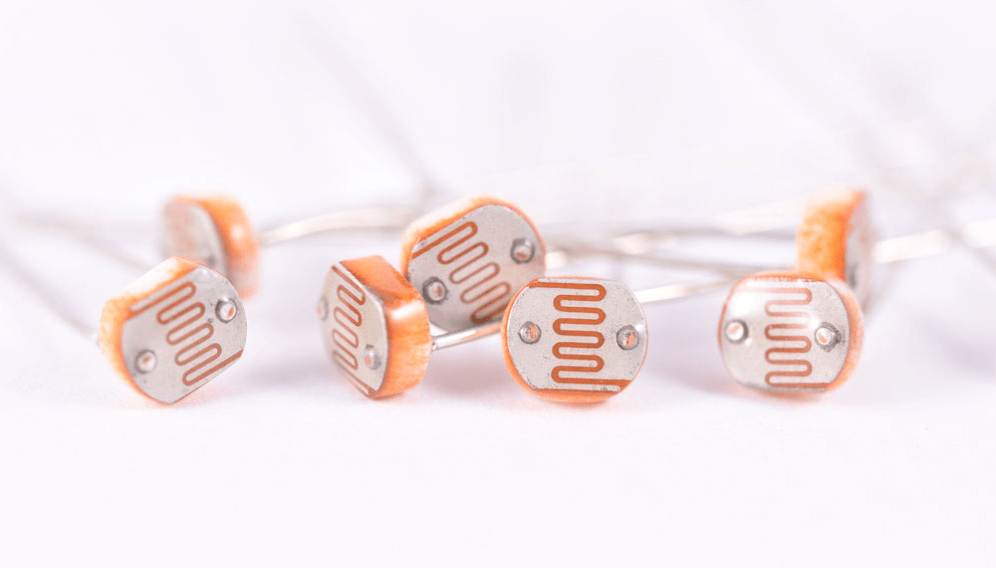
Figure 1: Light Dependent Resistors (LDRs)
Exploring Light Dependent Resistors
A light-dependent resistor (LDR), a photoresistor, is a basic component of electronic systems that requires light sensitivity. An LDR comprises a semiconductor material with high resistance, typically cadmium sulfide (CdS). This material's resistance changes significantly in response to the ambient light level. In low-light conditions, the LDR's resistance can be extremely high, reaching several megohms. As the light intensity increases, its resistance drops sharply, often down to a few hundred ohms. This dramatic shift in resistance makes LDRs particularly valuable for systems that need automatic light control, such as dusk-to-dawn lighting and various light-sensitive triggers.
Unlike other light-sensitive devices like photodiodes and phototransistors, LDRs do not use a PN junction. Instead, they operate based on the photoconductivity of the material, which classifies them as passive components. Due to health and environmental concerns, particularly in Europe, the use of cadmium in these devices has decreased. This has led to the adoption of alternative materials like lead sulfide (PbS) and indium antimonide (InSb). These alternatives not only comply with stricter regulations but also provide specific responses to different light wavelengths, expanding the range of applications for LDRs in modern electronics.
The key characteristics of LDRs, such as their response time and sensitivity to various light wavelengths, make them influential in circuits that require variable resistance based on the surrounding light. This dynamic capability is used in practical applications like light meters, where accurately measuring light intensity is a must. It's also found in adaptive street lighting, which adjusts brightness according to the natural light levels to improve energy efficiency. Despite advances in other light-detection technologies, the versatility and simplicity of LDRs ensure their continued use in a wide range of optical and light-sensitive systems.
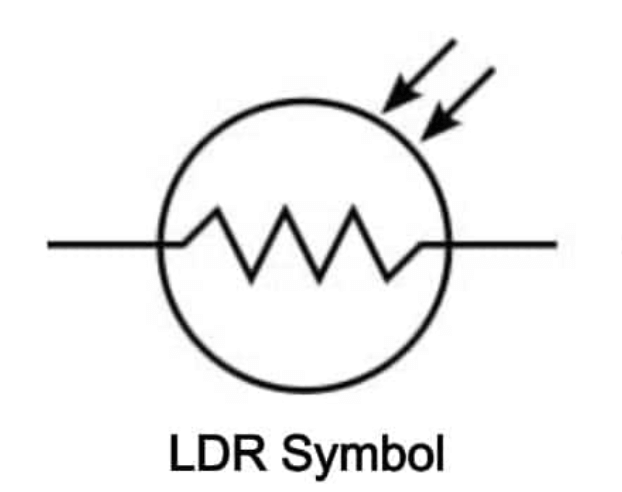
Figure 2: LDR Symbol
Decoding the Symbols
In electronic schematics, the symbol for a Light Dependent Resistor (LDR) is a variation of the standard resistor symbol, enhanced with arrows that indicate the impact of light on the device. These arrows suggest that the resistor’s behavior changes with light exposure. This adaptation aligns with the visual conventions used for other light-sensitive components like photodiodes and phototransistors, making their function easily recognizable. To simplify circuit diagrams, the surrounding circle, often part of the resistor symbol, may be left out. This omission helps reduce clutter, making the schematic clearer and easier to follow.
This symbolic representation is used for quick identification, ensuring that anyone reading the diagram can immediately understand the LDR’s role in the circuit. It also fosters effective communication within design teams, highlighting the unique characteristics of the LDR right away. In complex circuit designs, these symbolic differences are dynamic, helping to minimize mistakes during assembly and testing
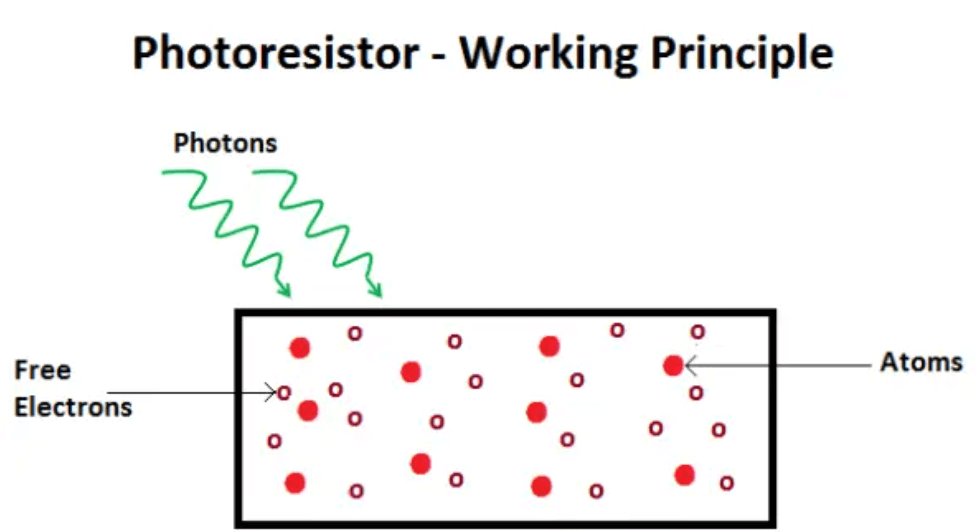
Figure 3: LDR Working Principle
Mechanics of LDR Operation
A Light Dependent Resistor (LDR) functions based on the principle of photoconductivity. When there is little or no light, the semiconductor material inside the LDR—often cadmium sulfide—has a high resistance. This occurs because, in darkness, most electrons remain bound within the crystal structure of the semiconductor, leaving few free electrons available to carry an electrical current.
When light shines on the LDR, the semiconductor absorbs photons. These photons transfer energy to the bound electrons, freeing them from their positions in the crystal lattice. As these electrons become free carriers, the material's resistance drops. The more intense the light, the more electrons are freed, further lowering the resistance. This reduction in resistance is directly linked to the intensity of the incoming light, allowing the LDR to convert changes in light levels into corresponding changes in electrical resistance.
This capability makes LDRs useful as analog transducers, where they translate light intensity variations into electrical signals. Such a characteristic is ideal for applications that require automatic responses to changing light conditions, like light-sensitive switches or systems that adjust brightness automatically.
In practice, when integrating LDRs into a circuit, engineers must account for their response time and sensitivity to different light wavelengths. These factors are used to ensure that the LDR performs well in the intended application. In addition, the direct link between light and resistance means that the surrounding circuitry must be carefully calibrated. This ensures that the electrical output aligns with the desired performance, illustrating the precise interaction between the LDR's properties and the circuit's requirements.
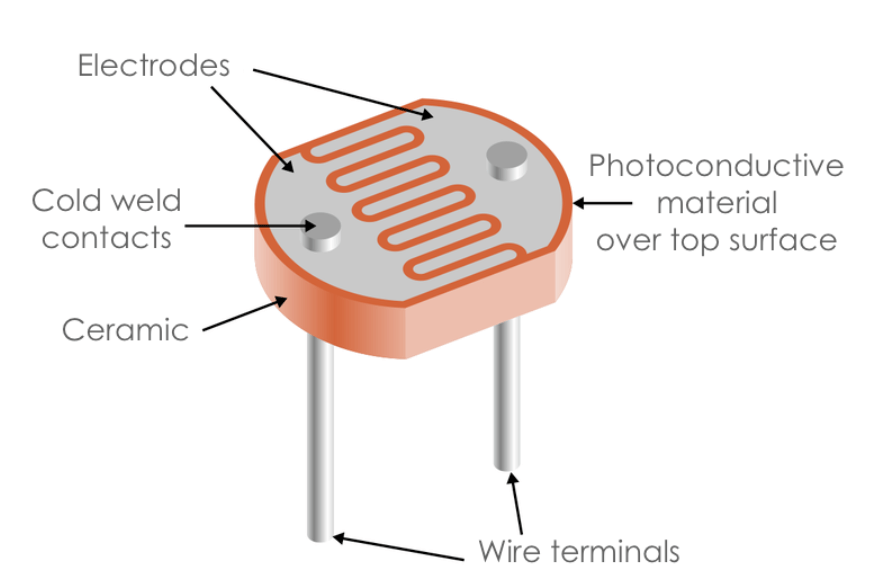
Figure 4: LDR Structure
Structure of LDRs
Photoresistors are designed with simplicity and effectiveness in mind, optimized to be highly responsive to light. The key component is the semiconductor layer, which is lightly doped and placed on a semi-insulating base. This doping process fine-tunes the semiconductor’s electronic properties, making it more sensitive to light. To further improve performance, the semiconductor’s surface often features an interdigital pattern—a series of interlocking fingers. This pattern increases the area exposed to light and reduces resistance at the contact points, which enhances the device’s overall electrical response.
The arrangement of these elements is insistent on maximizing light absorption while minimizing electrical losses. This design ensures that the photoresistor’s resistance changes quickly and efficiently as light levels vary. The choice of materials and the specific design directly affect the photoresistor’s sensitivity to different wavelengths of light. For example, cadmium sulfide is often used because it performs well across the visible-to-infrared light spectrum, making it ideal for outdoor light detection systems. Other materials might be chosen for applications that need sensitivity to different parts of the light spectrum.
Different Types of Photoresistors
Photoresistors, key components in light-sensing technology, are generally divided into two main types: intrinsic and extrinsic.
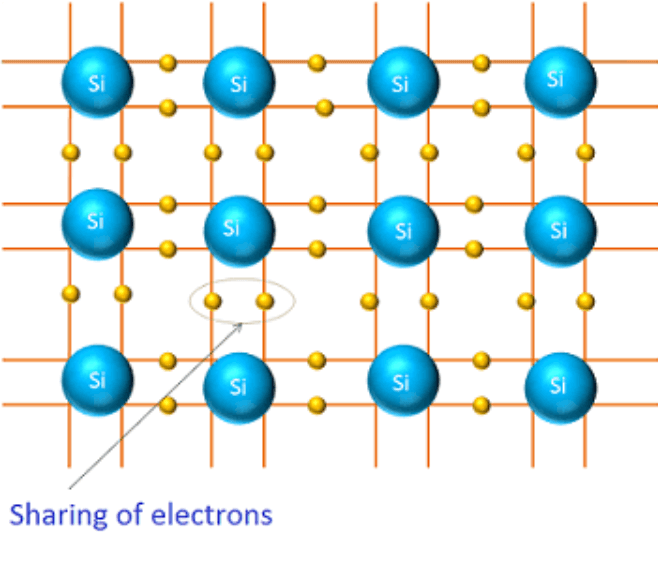
Figure 5: Intrinsic Photoresistors
Intrinsic photoresistors are made from pure semiconductor materials like silicon or germanium, without any added impurities. In these devices, when exposed to light, electrons are excited from the valence band to the conduction band, which reduces electrical resistance as more electrons become available to carry current. These photoresistors are most responsive to visible and ultraviolet light, making them ideal for applications that monitor standard light levels.
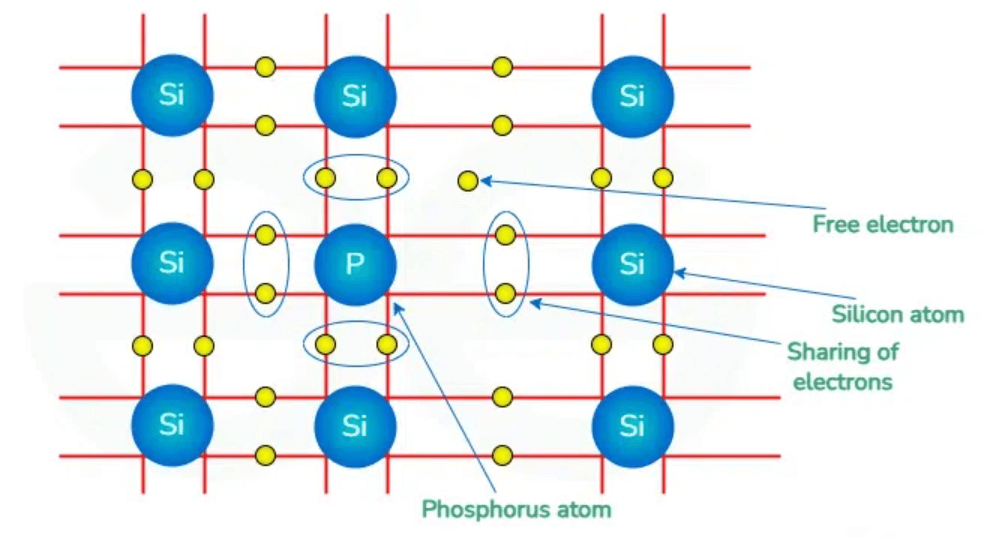
Figure 6: Extrinsic Photoresistors
Extrinsic photoresistors are doped with specific impurities to create additional energy levels near the conduction or valence band. This doping reduces the energy needed for electrons to move to the conduction band, increasing the photoresistor’s sensitivity, especially to longer wavelengths like infrared. Because of this enhanced sensitivity, extrinsic photoresistors are well-suited for detecting lower light levels or for use in infrared-sensitive applications.
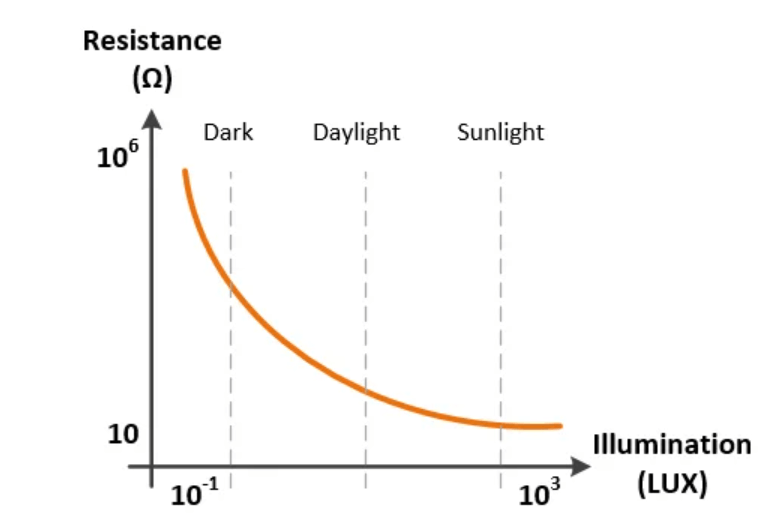
Figure 7: Frequency Response in Light Dependent Resistors
Frequency Response in Light Dependent Resistors
The effectiveness of Light Dependent Resistors (LDRs) in light detection hinges on their sensitivity to specific wavelengths, which is determined by the semiconductor material they are made from. Different materials offer unique spectral response profiles, allowing LDRs to be tailored for specific applications. For example, silicon-based LDRs are most responsive to visible light, while materials like lead sulfide are sensitive to infrared wavelengths, making them ideal for specialized uses such as infrared detection systems.
Selecting the right material for the LDR ensures that it operates effectively within the required spectrum. Using an LDR outside its optimal sensitivity range can result in poor performance, including slow responsiveness or inaccurate readings. Therefore, engineers must carefully match the material properties of the LDR with the light spectrum it will encounter in the application.
Latency in Light Dependent Resistors
The performance of Light Dependent Resistors (LDRs) in changing lighting conditions is closely tied to their response time, which is the time it takes for the LDR to adjust its resistance when light intensity changes. This latency can range from milliseconds to several seconds, depending on factors like the degree of light change and the specific material properties of the photoresistor.
In applications where light levels change quickly, such as security systems or optical signal processing, the response time of an LDR is important. If the LDR reacts too slowly, it can lead to delays or errors, compromising the system’s effectiveness. However, in other applications, like adjusting the brightness of a display based on ambient light, a slower response may be preferable. A gradual adjustment can help avoid flickering and create a smoother visual transition.
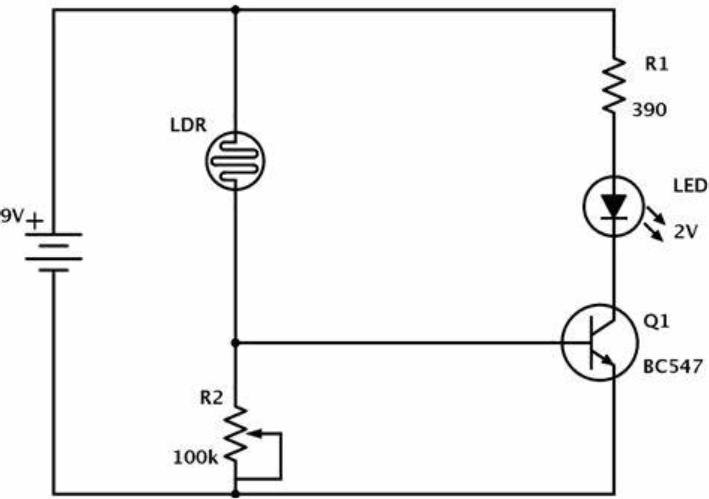
Figure 8: LDR Circuit
Basic LDR Circuit Configurations
When designing circuits with Light Dependent Resistors (LDRs), a common approach is to use them in a potential divider configuration. In this setup, the LDR is one part of the divider, and its resistance changes with light exposure. As the resistance shifts, it directly affects the output voltage of the divider, which can then control other parts of the circuit.
In practical applications, this changing output voltage might be used to drive a transistor, allowing the circuit to switch larger loads or modulate signals based on the amount of light. Alternatively, the output could be fed into an operational amplifier to amplify or modify the signal for specific tasks. These tasks could range from activating relays and powering LEDs to interfacing with microcontrollers for more complex responses.
Diverse Uses of Photoresistors
Photoresistors, or light-dependent resistors (LDRs), are dynamic components in many electronic devices due to their ability to change resistance based on light intensity. This characteristic allows them to be used in a wide range of applications, far beyond simple light detection.
|
Diverse Uses of Photoresistors |
|
|
Consumer Electronics |
In consumer electronics, photoresistors
are settling for devices that adjust screen brightness according to ambient
light, such as smartphones, tablets, and e-readers. By automatically dimming
or brightening the display, these sensors enhance user comfort and conserve
battery life. |
|
Industrial Applications |
In consumer electronics, photoresistors
are settling for devices that adjust screen brightness according to ambient
light, such as smartphones, tablets, and e-readers. By automatically dimming
or brightening the display, these sensors enhance user comfort and conserve
battery life. |
|
Automotive and Transportation |
The automotive industry leverages
photoresistors in automatic headlights and street lighting systems. These
sensors enable headlights to switch from high to low beam when detecting
oncoming vehicles or streetlights, enhancing safety and comfort during
nighttime driving. |
|
Art and Design |
In art and design, photoresistors are
used in interactive installations where lighting changes based on ambient
conditions or audience interaction. This allows for dynamic displays that
respond in real-time to environmental factors. |
|
Environmental Monitoring |
Photoresistors are also employed in
environmental monitoring, particularly in solar power systems. They help
optimize the angle of solar panels by tracking sunlight intensity throughout
the day, maximizing energy absorption and system efficiency. |
|
Security Systems |
In security systems, photoresistors
control automatic lighting based on natural light levels or detected
movements. They are also used in infrared sensors to detect the presence of
people or animals, enhancing security in sensitive areas. |
|
Health and Safety |
Photoresistors are used in devices that
monitor UV light to prevent overexposure, protecting health by ensuring safe
levels of UV radiation. They are also integral to fire and smoke detection
systems, offering early warnings by detecting light attenuation caused by
smoke particles. |
|
Research and Development |
In research, particularly in optics and
photonics, photoresistors are used to measure light properties and behaviors
under various conditions. This application will improve our understanding of light-matter interactions and facilitate the development of new technologies. |
Controlling an LED on Pin 13 with a Photoresistor
Using a Light Dependent Resistor (LDR) to control an LED is a simple and effective project, particularly when paired with a microcontroller like Evive. The key to this setup is the LDR's ability to change its resistance based on the amount of light it detects, which determines whether the LED will turn on or off according to a specified light threshold.
Here's how the process works: The LDR is part of a voltage divider, where its resistance changes with light exposure, altering the voltage output. This varying voltage is fed into the microcontroller’s analog input pin, which measures the light level. The microcontroller then runs a program that checks if the measured light level exceeds a set threshold defined in the code. If the light level crosses this threshold, the microcontroller activates Pin 13, turning the LED on.
Pros and Cons of Using Light-Dependent Resistors
Light Dependent Resistors (LDRs) are widely used in various electronic applications due to their ability to respond to changes in light levels. Below is a detailed discussion of the advantages and disadvantages of using LDRs.
Pros
Cost-Effectiveness: LDRs are inexpensive, making them a budget-friendly option for both small projects and mass production.
Easy Integration: LDRs are simple to incorporate into circuits, requiring few additional components and straightforward connections. This simplicity makes them accessible for beginners and practical for experienced designers.
Quick Responsiveness: LDRs respond rapidly to changes in light intensity, which is required for applications that rely on precise and timely light detection, such as automatic lighting systems, night lights, and light-activated alarms.
Versatility: LDRs can be used in a wide variety of devices and systems, ranging from hobbyist robotics projects to professional light meters, due to their effective light-sensing capabilities.
Low Power Consumption: LDRs operate with minimal power, making them ideal for battery-operated devices where conserving energy is grave.
Cons
Limited Wavelength Sensitivity: LDRs are sensitive to specific wavelengths of light, which can limit their performance in applications that require a broader range of spectral responses. They may struggle in low-light conditions or with colored lights outside their optimal sensitivity range.
Temperature Sensitivity: LDRs can be affected by temperature changes. In environments with significant temperature fluctuations, their resistance may vary, leading to less reliable or accurate readings.
Slower Response in Certain Conditions: While generally quick to respond, LDRs can exhibit slower response times when transitioning from light to dark, which can be problematic in certain applications.
Aging and Degradation: Over time, prolonged exposure to intense light can degrade LDRs, reducing their responsiveness and lifespan.
Non-linear Response: The resistance change in LDRs is not always proportional to the light intensity, which can complicate circuit design and calibration, especially in applications requiring precise measurements.
Conclusion
Light Dependent Resistors (LDRs) embody a serious component in the design of responsive electronic systems, serving a wide array of industries ranging from consumer electronics to advanced surveillance systems. Through the discussion presented, it is evident that LDRs not only offer versatility and simplicity but also pose unique challenges such as sensitivity to specific light wavelengths and response times, which must be meticulously considered in circuit design. Despite the emergence of more advanced light-sensing technologies, the cost-effectiveness and straightforward operation of LDRs ensure their continued relevance in both educational and industrial contexts.
As electronic systems evolve, the strategic integration of LDRs in applications requiring light sensitivity will continue to be a significant factor in the advancement of adaptive and efficient electronic designs. This article has illuminated the multifaceted aspects of LDRs, emphasizing their key role in modern technology and their ongoing adaptation in response to both technological and regulatory developments.
Frequently Asked Questions [FAQ]
1. Which resistor is used in LDR?
An LDR, or light-dependent resistor, primarily uses a photoresistor, a component whose resistance varies with light intensity. Typically, the material used is cadmium sulfide (CdS).
2. How does the LDR module work?
The LDR module includes a photoresistor as its main component. When exposed to light, the resistance of the photoresistor decreases. This change in resistance can be measured and used to control other parts of a circuit, such as switching lights on or off, depending on the light level.
3. What is the main characteristic of a light-dependent resistor (LDR)?
The primary characteristic of an LDR is its sensitivity to light. The resistance of an LDR decreases as the ambient light intensity increases. This feature makes it useful for light-sensing applications, where it acts as a switch that is activated by changes in light.
4. How to check if LDR is working?
To check if an LDR is working, you can use a multimeter set to measure resistance. Measure the resistance of the LDR in a dark environment and then again in a brightly lit environment. The resistance should be high in the dark and significantly lower in bright light if the LDR is functioning properly.
5. What does an LDR photoresistor do?
An LDR photoresistor controls electrical circuits based on light intensity. In practical applications, this might involve turning street lights on at dusk or adjusting the brightness of a display based on the surrounding light conditions. The LDR effectively serves as a light-sensitive trigger within various electronic devices.